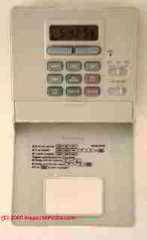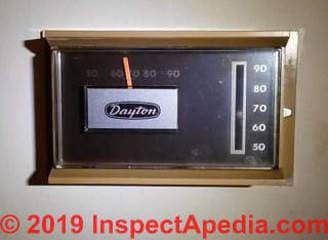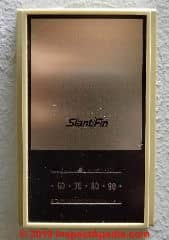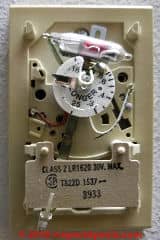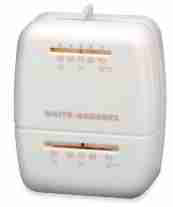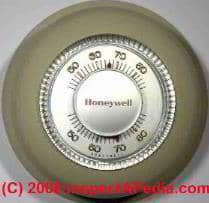 Where to Buy a Heat-Anticipator Thermostat
Where to Buy a Heat-Anticipator Thermostat
Do you need one? Where to get a heat anticipator
- POST a QUESTION or COMMENT about heating thermostat heat anticipators
Why & where to buy a room thermostat that includes a heat anticipator.
Here we discuss when you do or do not need a thermostat that includes a heat anticipator device, modern alternative thermostat controls, and where to buy a thermostat with a heat anticipator feature.
Do I need a thermostat with a heat anticipator? Where to Buy a Room Thermostat with a Heat Anticipator.
This article series explains what a heat anticipator is on a wall thermostat, where to find it, what it looks like, why we adjust the heat anticipator, how we do so.
InspectAPedia tolerates no conflicts of interest. We have no relationship with advertisers, products, or services discussed at this website.
- Daniel Friedman, Publisher/Editor/Author - See WHO ARE WE?
Why & Where to Buy a Cooling or Heating Wall Thermostat with a Heat Anticipator
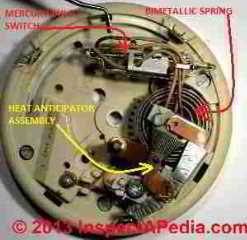
Some room heating & cooling thermostats include a "heat anticipator" adjustment which is tuned to the particular air conditioning, heat pump or heating system to avoid system on-off oscillating too close to the thermostat's set point and to adjust for over-shoot or under-shoot of the desired room temperature that was set on the room thermostat.
We will also discuss when you do or do not need a thermostat that includes a heat anticipator device, modern alternative thermostat controls, and where to buy a thermostat with a heat anticipator feature.
Our photo illustrates key parts of a traditional room thermostat including the temperature sensing device, thermostat switch, and the heat anticipator assembly.
[Click to enlarge any image]
What if my Thermostat Does Not Have a Heat Anticipator? Do I need one?
Well you may not need a heat anticipator in your thermostat.
As we discuss in detail immediately below, for many types of heating system distribution, heat source, and heat controls, you don't need a heat anticipator, while for certain types of heating systems (such as those using heavy cast iron radiators) using a heat anticipator can provide important improvements in heating system operation.
But first let's define three thermostat heat anticipator categories:
- Room thermostats that do not include a heat anticipator function. The majority of both non-programmable and programmable wall thermostats currently for sale do not include a heat anticipator feature.
Instead these devices advertise that they are capable of regulating room temperature within a specific range, usually given as +/- 3 deg F. or +/- 1 °F.
In many modern homes these thermostats will be perfectly satisfactory, though not in all, as we will explain below. - Room thermostats that include a simplified heat anticipator-like function in the form of micro switches. In these thermostats the installation instructions will refer to the switch or switches using terms like "Set the fan operation switch" or better, "Set Cycle Rate Switches" Instructions will typically give the situations described in the table
at THERMOSTAT CYCLE RATE SWITCH.
In that article you'll see that some thermostats such as the 3M-22 Filtrete programmable thermostat includes a Swing or Cycle Rate setting that is very similar in function to a traditional heat anticipator setting.
- Room thermostats that do include an adjustable heat anticipator feature. These are described below
at WHERE to BUY a ROOM THERMOSTAT WITH a HEAT ANTICIPATOR
Reasons to Buy A Wall Thermostat that Includes a Heat Anticipator feature
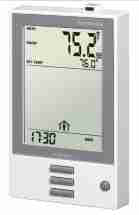
Heating distribution systems that have high thermal mass (cast iron radiators or cast-iron baseboards) tend to continue emitting heat after the boiler shuts down - thus possibly heating the room well past the thermostat's set temperature.
Popularly, this phenomenon is called temperature overshoot. On the other hand, an improperly adjusted or installed thermostat can also cause too-frequent burner on-off cycles, wasting heating fuel.
In these cases we can use a heat anticipator-equipped thermostat to advantage.
Other heating systems with thermal mass such as an in-floor radiant heat system, particularly if the floor is a concrete slab or a blockbed solar heat system might also benefit from a room thermostat that has a heat anticipator function.
But we notice that at least some thermostats sold for radiant floor heating, such as the OJ programmable floor thermostats UTN-4991 and the OJ UDG-4999 (shown at left), designed to monitor both floor temperature and air temperature, do not include a heat anticipator.
Question: Helpful Pointers Heat-Anticipators
... [other text relocated to pertinent article]3. Heat-anticipators are typically only found in mechanical (non-digital) thermostats. Whenever installing or servicing a thermostat with a heat-anticipator, the amperage setting on the heat-anticipator should always be verified as matching the amperage draw on the gas valve or relay that it controls. Otherwise the relay or thermostat may not function properly.
- Helpful Pointers Regarding 24V T 10/27/2012
Reply:
Helpful, thanks so much for the detailed tips on wiring 24-volt room thermostats. I've inserted your remarks into the main article body over
at THERMOSTAT WIRE CONNECTIONS -
and in that article beginning in a new section at
9 THERMOSTAT WIRING TIPS & COLOR CODE CONVENTIONS.
Actually, though, a recent search (2013) found that there are indeed contemporary digital and programmable thermostats that do include a heat anticipator, though I agree that many models do not include that feature. In a later FAQ just below we point out the types of heating systems that do and don't benefit from a heat anticipator function in a room thermostat.
Working together and exchanging information makes us better informed than any individual can be working alone. - Ed
Types of Heat for Which You Do Not Need a Thermostat with a Heat Anticipator
 Low thermal mass heating systems:
Low thermal mass heating systems:
other heating distribution systems that have low thermal mass (copper tubing baseboard) or no thermal mass (warm air heat and ductwork) stop emitting heat quickly (thin wall copper baseboard) or immediately (forced warm air heat) when the boiler or furnace is shut off by the thermostat.
Those systems don't need and don't benefit from a heat anticipator.
Fan coil type heating systems
are, like forced warm air heaters, an "on-off" type heat with no significant thermal mass. You'll find that thermostats sold for use with fan coil heaters, like PECO's TA180-001 digital programmable thermostat do not include a heat anticipator.
Similarly, electric baseboard heat thermostats
or electric floor heating mat thermostats typically won't include heat anticipators, though you can purchase thermostats with varying degrees of room temperature variation such as +/1 1 °F or +/3 3 °F.
Shown at above left is the Honeywell T498B1512 120V wall thermostat used for electric baseboard heat. ($50.) This thermostat is designed to maintain heat within a temperature differential of +/- 3 degrees F.
If you need to control electric heat and want a more narrow temperature differential range, check out the Honeywell TL7235A100 non-programmable line voltage digital thermostat or the White Rodgers line voltage snap action room thermostat model 1A65-641 [illustration] that controls temperatures to +/- 1 degree F. ($40.)
For a programmable electric heat thermostat see the Dayton 1UHG4 [illustration] line voltage thermostat. Electric heat thermostats are discussed
a second type of improvement in heating thermostat controls may also have obviated the need for heat anticipators.
A second reason (besides room temperature overshoot) for the original inclusion of heat anticipators was to allow the installer to widen or narrow the precision of the "on-off" response of the wall thermostat.
This prevented a thermostat from bouncing rapidly between on-and off which could happen if the thermostat was both very sensitive to room temperature and the room temperature changed too rapidly.
Modern thermostats are quite reliable at holding to a +/1 one degree temperature range.
Homes with stable indoor temperatures:
after super-insulating our lab with blown-in foam insulation, we found that its temperature remains very stable - the building is slow to cool down and slow to warm up as outdoor temperatures change. The single largest factor is probably the elimination of uncontrolled air leakage.
Many modern homes are better insulated so cool off more slowly so temperature changes more slowly, and in some homes installers have got smart enough in locating the wall thermostat that it's not placed on a cold outside wall nor in direct path of blowing hot or cold air.
What happened to the bimetallic spring and mercury bulb in thermostats? What about the heat anticipator?
Modern digital room thermostats don't use a bimetallic spring to sense room temperature. And for environmental reasons (mercury is highly toxic) manufacturers no longer use a mercury bulb to control the switching of a wall thermostat.
Rather they use a solid state thermistor. A thermistor is a device whose electrical resistance changes in response to temperature. A microprocessor chip in the digital room thermostat converts that change in resistance to a temperature reading.
Manufacturers of Room Thermostats Including a Heat Anticipator
There are definitely modern wall thermostats that still use a heat anticipator, though its physical form has changed from the tiny coil over which a pointer slides to a thin wire mounted on a disc, still encompassing a movable arm that contacts the wire at different points along its length.
The operating principle is the same: shorter wire, less resistance, more current flow, more heating. Here are some room thermostats that include a heat anticipator:
- Dayton Room Thermostats with heat anticipators
- Some models such as the Dayton 2E156 include a heat anticipator adjustment.
Shown above, compliments of reader Tom from Bethlehem PA, Tom commented:
Perhaps as old as the house, mid 70's. I had touched it up with a bit of Deoxit this fall. I'll be interested to see how sungle digit outside temps change the indoor temp swing but right now its less than 2 degrees.
See also LINE VOLTAGE THERMOSTATS
- Honeywell Room Thermostats with heat anticipators
- T87N1000 includes a heat anticipator feature - up to $50.
- Honeywell T87A, B, J round thermostats include an adjustable heat anticipator - about $25. U.S.
- Honeywell Room Thermostat T87K1007 includes a heat anticipator feature - about $40.
- Lux Room Thermostats - mechanical non-programmable room thermostat, model LT101141SA-006 - about $27. U.S.
- LuxPro PSM40SA Heat & Cool Thermostat - about $25 at big box stores or sold online
- Robertshaw Room Thermostdats
- 9701i2, Robertshaw 8725i2, and Robertshaw 9801i2 programmable digital thermostats all include a heat anticipation range adjustable between 1-3 degrees F - about $150-200. single stage heating, cooling, or heat pump control. Also see the Robertshaw 9825i2 for 3-stage heat control.
- SlantFin Room Thermostats with heat anticipator
- Shown above, vintage 1967, included a heat anticipator. This thermostat is installed in a northern Minnesota home and controls a hydronic heating zone.
Although sold under the SlantFin brand name the thermostat shown above was actually designed and manufactured by Honeywell Corp. in Minneapolis. The words Honeywell and Mpls Minn are embossed inside of the thermostat's plastic cover. - White-Rodgers Room Thermostdats with heat anticipator
- heat-only Model 1C20-101 - about $20. [Shown below]
- The largest selection of room thermostats we find anywhere is at Grainger who has over 250 models in their online catalog. http://www.grainger.com - but beware not every thermostat description necessarily names all features.
...
Reader Comments, Questions & Answers About The Article Above
Below you will find questions and answers previously posted on this page at its page bottom reader comment box.
Reader Q&A - also see RECOMMENDED ARTICLES & FAQs
Question: Where can I buy a room thermostat that has a heat anticipator? Big box stores don't carry thermostats that include a heat anticipator
Stopped at a local big box store and looked at the models on display, called Honeywell while there and was told that typical retail outlets like these DON'T carry thermostats that have anticipator functions or a heat control differential and they are set to stay within +/- 1 degree at all times.
The Honeywell tech could not give me part numbers but said that those units are normally only sold to HVAC installers through their distributors. - Mike at Longmeadow MA
Reply: Where to Buy a Room Thermostat with a Heat Anticipator Feature
Thanks for this field report on the availability of room thermostats that include a heat anticipator.
You're sure right. I stopped by a local Home Depot store, checked out a local Radio Shack, and also shopped at the one remaining lumber yard/building supplier in our area who hasn't been driven out by big box store competition.
None of them stocked a room thermostat that included a traditional heat anticipator, though some newer room thermostats provide a very similar function in the form of micro-toggle-switches inside the unit.
But it is in fact still easy to find a wall thermostat that includes a heat exchanger by a little careful shopping, as I detail below. I think part of what you heard from the Honeywell tech was less than clear or less than forthcoming. Or maybe s/he was not fully informed about the company's products. Or maybe the tech didn't even know what a heat anticipator is or why they are sometimes used in thermostats.
Following some explanation, just below at I include a list of room thermostats that include a heat anticipator - including
WHERE to BUY a THERMOSTAT with a HEAT ANTICIPATOR
from Honeywell, Lux, Robertshaw and White-Rodgers. Perhaps you'll want to forward a copy of this article to the Honeywell "tech" with whom you spoke by telephone.
The question of whether or not you need or should want a thermostat that includes a heat anticipator feature is discussed
Heat Anticipator Adjustment 101: Simplified anticipator operation, setting, tweaking & Ohms Law
This discussion has moved to HEAT ANTICIPATOR ADJUSTMENT - T87
...
Continue reading at HEAT ANTICIPATOR OPERATION or select a topic from the closely-related articles below, or see the complete ARTICLE INDEX.
Or see these
Recommended Articles
- AMPS MEASUREMENT AUTOMOTIVE DC
- AMPS MEASUREMENT METHODS
- BOILER CONTROLS & SWITCHES
- DEFINITION OF AMPS, ELECTRICAL CURRENT
- DEFINITION OF OHMS, ELECTRICAL RESISTANCE
- ELECTRICAL RESISTANCE vs HEAT GENERATED
- FURNACE CONTROLS & SWITCHES
- HEAT ANTICIPATOR ADJUSTMENT
- HEAT ANTICIPATOR ADJUSTMENT - T87
- HEAT ANTICIPATOR EFFECTS on ROOM TEMPERATURE
- HEAT ANTICIPATOR OPERATION
- HEAT ANTICIPATOR SET & TEST by AMMETER
- HEAT ANTICIPATOR THERMOSTAT SOURCES
- HEAT WON'T TURN OFF
- STEAM HEATING SYSTEMS
- TEMPERATURE RESPONSE of ROOM THERMOSTATS
- THERMOSTAT WIRE CONNECTIONS
- VOLTS / AMPS MEASUREMENT EQUIP
Suggested citation for this web page
HEAT ANTICIPATOR THERMOSTAT SOURCES at InspectApedia.com - online encyclopedia of building & environmental inspection, testing, diagnosis, repair, & problem prevention advice.
Or see this
INDEX to RELATED ARTICLES: ARTICLE INDEX to HVAC THERMOSTATS
Or use the SEARCH BOX found below to Ask a Question or Search InspectApedia
Ask a Question or Search InspectApedia
Try the search box just below, or if you prefer, post a question or comment in the Comments box below and we will respond promptly.
Search the InspectApedia website
Note: appearance of your Comment below may be delayed: if your comment contains an image, photograph, web link, or text that looks to the software as if it might be a web link, your posting will appear after it has been approved by a moderator. Apologies for the delay.
Only one image can be added per comment but you can post as many comments, and therefore images, as you like.
You will not receive a notification when a response to your question has been posted.
Please bookmark this page to make it easy for you to check back for our response.
IF above you see "Comment Form is loading comments..." then COMMENT BOX - countable.ca / bawkbox.com IS NOT WORKING.
In any case you are welcome to send an email directly to us at InspectApedia.com at editor@inspectApedia.com
We'll reply to you directly. Please help us help you by noting, in your email, the URL of the InspectApedia page where you wanted to comment.
Citations & References
In addition to any citations in the article above, a full list is available on request.
- [1] Proliphix Corporate Headquarters [Website: proliphix.com] , 3 LAN Drive Suite #100, Westford, MA 01886 Phone: +1.978.692.3375 Toll Free (U.S.): 866-IP-LIVING (866.475.4846) Fax: +1.978.692.3378 - Sales: sales@proliphix.com Marketing: marketing@proliphix.com Customer support: support@proliphix.com http://www.proliphix.com/ - quoting from the company's website:
All Proliphix Network Thermostats come with our free Uniphy Remote Management Service. This unique offering lets you monitor and control your HVAC systems by simply pointing your Browser to our secure Proliphix Web Site. Enjoy the convenience of programming a thermostat from any location, using a simple graphical interface. No computer equipment or software is required. And since Proliphix takes care of the network configuration for you, you’ll be up and running in no time. We’ll even proactively monitor your thermostats and send you an immediate email or SMS message when an HVAC problem is detected. - [2] "The Nest Learning Thermostat", Nest Thermostat, 900 Hansen Way Palo Alto, CA 94304, Tel: 855-4MY-NEST, Email: info@nest.com, website http://www.nest.com/, retrieved 1/24/2013.
- [3] Honeywell Controls, the company wants you to use their contact form at this web page: http://www51.honeywell.com/honeywell/contact-support/contact-us.html
Honeywell Consumer Products, 39 Old Ridgebury Road Danbury, CT 06810-5110 - (203) 830-7800
World Headquarters, Honeywell International Inc., 101 Columbia Road, Morristown, NJ 07962, Phone: (973) 455-2000, Fax: (973) 455-4807 1-800-328-5111 - [3a] Honeywell Tradeline T87T Universal Thermostat Installation Instructions for the Trained Service Technician", Honeywell International Inc. Honeywell Limited—Honeywell Limitée 1985 Douglas Drive North 35 Dynamic Drive Golden Valley, MN 55422 Scarborough, Ontario M1V 4Z9, 60-0830—4 G.H. Rev. 8-02, retrieved 12/1/2013 Website: www.honeywell.com
- [3b] Honeywell CT87A,B,J Round® Themostat Low Voltage (15 to 30 VAC) Thermostat and Mounting Hardware Installation Instructions, Honeywell International Inc. Honeywell Limited—Honeywell Limitée 1985 Douglas Drive North 35 Dynamic Drive Golden Valley, MN 55422 Scarborough, Ontario M1V 4Z9, 60-0830—4 G.H. Rev. 8-02, retrieved 12/1/2013 Website: www.honeywell.com
- [4] White Rodgers Thermostats and HVAC controls,
Homeowner information: http://www.emersonclimate.com/en-US/brands/white_rodgers/Pages/wr-homeowner-info.aspx
Contractor information: http://www.emersonclimate.com/en-US/brands/white_rodgers/wr_contractor_info/Pages/white-rodgers-contractor-info.aspx
White Rodgers Product Catalog (don't misspell the company's name as White Rogers Thermostats) -
http://www.emersonclimate.com/Documents/thermostats.pdf - Thermostat Catalog - [5] Domestic Central Heating Wiring Systems and Controls, 2d Ed., Raymond Ward, Newnes, ISBN-10: 0750664363, ISBN-13: 978-0750664363, Quoting from Amazon.com:
This unique A-Z guide to central heating wiring systems provides a comprehensive reference manual for hundreds of items of heating and control equipment, making it an indispensable handbook for electricians and installers across the country. The book provides comprehensive coverage of wiring and technical specifications, and now includes increased coverage of combination boilers, recently developed control features and SEDBUK (Seasonal Efficiency of Domestic Boilers in the UK) boilers ratings, where known.
In addition to providing concise details of nearly 500 different boilers fuelled by electric, gas, oil and solid fuel, and over 400 programmers and time switches, this invaluable resource also features numerous easy-to-understand wiring diagrams with notes on all definitive systems. Brief component descriptions are provided, along with updated contact and website details for most major manufacturers. - In addition to citations & references found in this article, see the research citations given at the end of the related articles found at our suggested
CONTINUE READING or RECOMMENDED ARTICLES.
- Carson, Dunlop & Associates Ltd., 120 Carlton Street Suite 407, Toronto ON M5A 4K2. Tel: (416) 964-9415 1-800-268-7070 Email: info@carsondunlop.com. Alan Carson is a past president of ASHI, the American Society of Home Inspectors.
Thanks to Alan Carson and Bob Dunlop, for permission for InspectAPedia to use text excerpts from The HOME REFERENCE BOOK - the Encyclopedia of Homes and to use illustrations from The ILLUSTRATED HOME .
Carson Dunlop Associates provides extensive home inspection education and report writing material. In gratitude we provide links to tsome Carson Dunlop Associates products and services.


